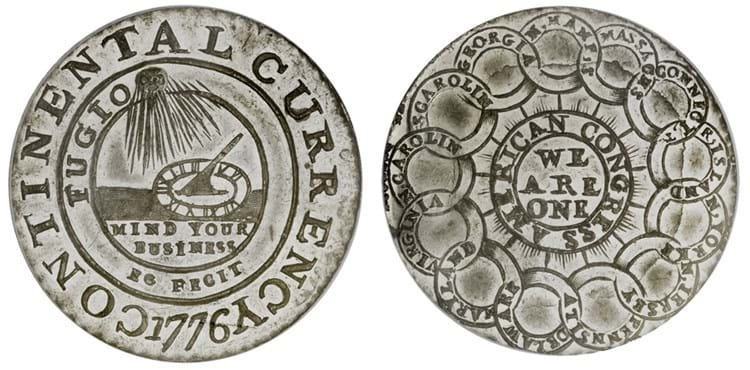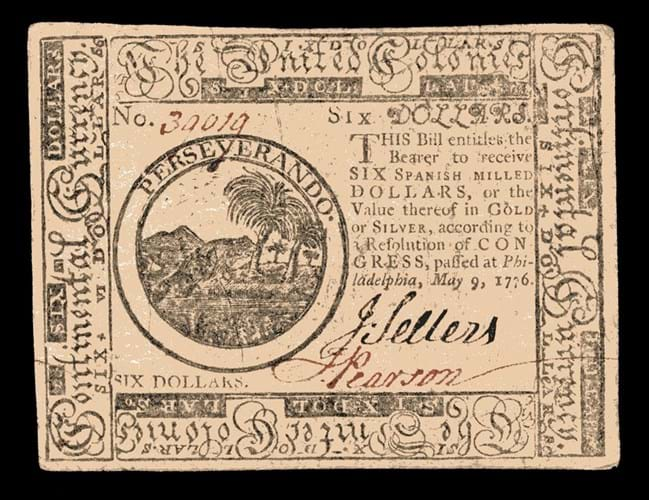
The 1776 pewter Continental Dollar is estimated at $100,000-150,000 ahead of the June 19-20 sale, but Spink says such pieces are “mysterious and controversial”.
Little documentation has been uncovered regarding their origin and use – such as who made them and whether they are coins or actually patterns.
A Spink spokeswoman said: “The Guide Book of United States Coins states ‘Pewter pieces served as a dollar. Brass and silver pieces may have been experimental or patterns’.”
However, she added that in Walter Breen’s Complete Encyclopedia of US Coins (1988) he listed them under the heading of ‘Continental Congress Patterns’.
"He used quotes around the word ‘dollar’ when he described the pewter pieces, but called the one silver piece he was aware of a dollar (without quotes), giving the impression that Breen thought the silver piece was a coin, and the pewter pieces patterns.”
First US money

Paper Continental Currency 1776 six-dollar note estimated at $100-150 in the June 19-20 Spink sale in New York.
The colonies lacked the funds to proceed with a lengthy war of independence. In June 1775, Congress issued $2 million in bills of credit – the paper money of Continental Currency was born.
Again according to Breen, in 1776 the United Colonies expected to receive a large loan in the form of silver bullion from France. They anticipated using the silver to produce coins to back the paper Continental Currency already circulating, in an attempt to create confidence in any subsequent paper issues.
Representatives of the United Colonies also hoped to be able to give some of the new coins to visiting diplomats, demonstrating that this was a real nation, with coins to prove it. To obtain dies, agents of the Continental Congress approached Elisha Gallaudet (the engraver of the Continental Currency notes with the sun dial design). The coins are marked on the obverse EG FECIT – made by EG.
The same agents also apparently advised Hall and Sellers (the printers of Continental Currency notes) that $1 coins were about to be struck, and no further $1 notes would be needed.
But the French loan failed to materialise, leaving the United Colonies with no silver dollars to circulate, and none to give out as diplomatic gifts. There was, however, a supply of tin, antimony and lead available for pewter, and the already prepared dies were employed to strike the coins, perhaps in New York, and later in Philadelphia.
The Spink spokeswoman added: “When the Revolutionary War ended, departing British soldiers may well have carried some examples home with them as souvenirs, accounting for the uncirculated pieces that have been discovered in Europe over the years. We would argue that while the two known silver Continental Dollars are patterns, and the brass pennies are patterns, the ‘pewter’ pieces are coins.”
The US Mint was established in 1792 and regulated the coinage.
More 1776 dollars at auction
In May 2014 Heritage Auctions sold a 1776 Continental Currency dollar struck in silver for a premium-inclusive $1.41m May 16 in the New York sale of Part IV of the Eric P Newman Collection.
In August 2015 in Chicago Heritage sold a 1776 Continental Currency pewter dollar for a premium-inclusive $10,575, but earlier that year in January another in better condition went for $88,125. Prices are very reliant on condition – another described by Heritage as “virtually perfect for a coin that is more than 200 years old” took $546,250 in January 2012.
In April 26 this year yet another sold for $108,687.50 but others in the same sale made around $37,000-42,000.
A Heritage catalogue note does say: “Most 1776 Continental dollars were struck in pewter, and these seem to have circulated to some extent, as they are seen in all grades today. A few examples are known in silver and brass compositions, but these are extremely rare.”





